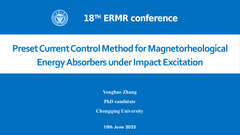Preset current control method for magnetorheological energy absorbers under impact excitation
ID:23
Submission ID:49 View Protection:ATTENDEE
Updated Time:2023-05-21 20:34:57
Hits:807
Oral Presentation
Abstract
The damping force of a magnetorheological energy absorber (MREA) is directly proportional to the square of the piston velocity, resulting in a significant decline in damping force when the buffering velocity decreases, leading to an unsatisfactory performance. By adjusting the current intensity of the electromagnetic coil, the damping force of the MREA can be regulated. However, real-time control of impact mitigation is challenging due to the short duration and severe fluctuation of impact forces. A preset current control method for MREAs under impact excitation is proposed. During the occurrence of an impact, the current controller outputs a pre-set current waveform, which enables the output of constant damping force within the impact stroke, thereby improving the buffering efficiency. The mechanical characteristics of the MREA are established based on the Herschel-Bulkley (HB) constitutive model, considering minor losses. The governing equations of the flow channel are derived from the Navier-Stokes equation and continuity equation. By solving the governing equations and applying the boundary and initial conditions, the damping force is obtained. The waveform of the preset current is determined based on the dynamic model of the MREAs. A group of disc springs is used as the elastic restoring element. Two prototype MREAs are fabricated, and a high-speed drop tower is constructed to test the dynamic behavior under constant current and preset current conditions. Experimental results confirm that the MREAs under preset current conditions achieve the desired damping force and exhibit smoother output compared to constant current operation. This demonstrates the effectiveness of the proposed preset current control method in enhancing MREA buffering efficiency.
Keywords
magnetorheological energy absorber;preset current control;impact;Herschel-Bulkley model
Submission Author
Yonghao Zhang
Chongqing University
Honghui Zhang
Chongqing University
Changrong Liao
Chongqing University
Ruixue Sun
Chongqing University
Lei Xie
Chongqing University


Comment submit